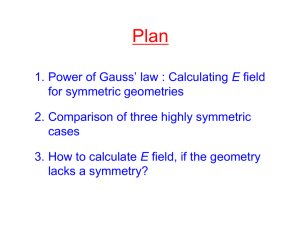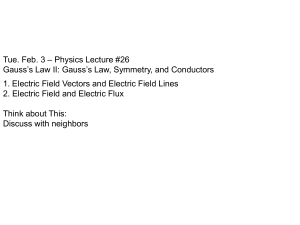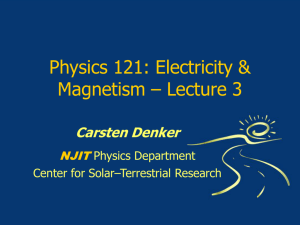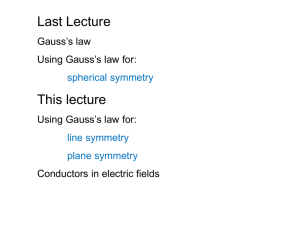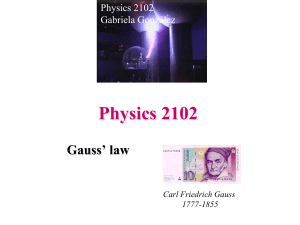Chapter 23: Gauss’ Law PHY2049: Chapter 23 1
advertisement
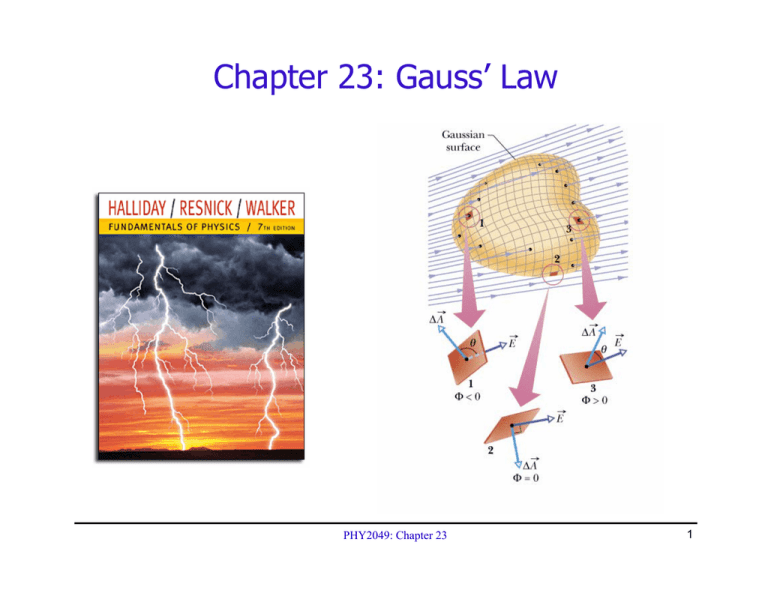
Chapter 23: Gauss’ Law PHY2049: Chapter 23 1 Conductors with No Current ÎE is zero everywhere inside Why? Conductors are full of mobile charges (e.g., conduction electrons in a background formed by immobile positive ions). If there were E, then the charges must be moving around due to force F=qE. This would contradict “no current.” Note: even if there is an externally imposed E, it cannot go inside ÎAll excess charge must be on outer surface. Why? Since E=0 everywhere inside, qenc enclosed by any Gaussian surface is also zero everywhere inside. Note: distribution of surface charge must be such to make E=0 everywhere inside ÎE is always normal to surface on conductor Why? E component parallel to surface would cause surface charge to move. This would contradict “no current.” PHY2049: Chapter 23 2 Spherical Symmetry (1) Uniformly Charged Sphere ÎInsulator or conductor? Conducting sphere cannot be uniformly charged ÎInside symmetry, E must be radially symmetric E field has constant mag., ⊥ to Gaussian surface + + + + By Gauss’ Law qenc ∫SE ⋅ dA = E (4πr ) = ε0 2 3 Qr / R 1 Qr E= = 2 4πε 0 R 3 4πε 0 r ÎOutside Solve for E 1 Q E= 4πε 0 r 2 + + + + + + + + + + + + + + + + Q + + + + + + + + + + + + + + + + + + + + + + + + + + Gaussian surface r 3 (sphere) 4 3 ρ ( πr ) = Q 3 3 R 3 + + + + + + ρ= Q 4 3 πR 3 Q PHY2049: Chapter 23 3 Spherical Symmetry (2) Concentric Conducting Spherical Shell ÎInside conductor E Must be 0 must be 0 qenc ∫SE ⋅ dA = 0 = ε0 + – Gauss’ Law Charge can be only on surfaces +Q uniformly distributed on inner wall ÎOutside By symmetry, E must be radially symmetric E field has constant mag., ⊥ to Gaussian surface q enc ∫SE ⋅ dA = E (4πr ) = ε0 2 – – −Q Gauss’ Law – Q uniformly distributed on outer surface PHY2049: Chapter 23 + – + – + + -Q + + – + – – + + – – + + – – Gaussian surface (sphere) Points toward shell 1 Q E=− 4πε 0 r 2 4 Spherical Symmetry (2) Concentric Conducting Spherical Shell ÎNote: Problem 23-4 on page 614 In this problem, point charge –Q in cavity is not at center. This makes the problem harder. In particular, you do not need to understand explanation given in book for why charge on outer surface is uniform. Rigorous explanation in fact requires a tool, so-called uniqueness theorem, which is beyond introductory physics. PHY2049: Chapter 23 5 Axial Symmetry (1): Line Charge ÎInfinitely long line, uniformly charged By symmetry, E must be axially symmetric On curved surface, E field has constant mag., ⊥ to Gaussian surface Through top and bottom surfaces, no ΦE since E is || λh qenc ∫SE ⋅ dA = E (h2πr ) + 0 + 0 = ε0 Gauss’ Law 1 λ E= 2πε 0 r Solve for E PHY2049: Chapter 23 6 Axial Symmetry (2): Uniformly Charged Cylinder ÎInfinitely tall cylinder, uniformly charged R By symmetry, E must be axially symmetric On curved surface, E field has constant mag., ⊥ to Gaussian surface Through top and bottom surfaces, no ΦE since E is || 2 ρ r ρ ( hπr ) qenc ∫SE ⋅ dA = E (h2πr ) + 0 + 0 = ε0 1 E= ρr Solve for E 2ε 0 h Gauss’ law Gaussian surface (cylindrical) PHY2049: Chapter 23 7 Rectangular Symmetry (1): ÎInfinitely Uniformly Charged Sheet wide and tall symmetry, E must be ⊥ , same on both sides By σ (πr 2 ) q enc ∫SE ⋅ dA = E (πr ) + E (πr ) + 0 + 0 = ε0 2 σ E= 2ε 0 ÎParallel 23-8 2 Solve for E Gauss’ law Constant! conducting plates: read Section PHY2049: Chapter 23 8 Some Comparisons ÎSpherically symmetric charge distribution 1 qtotal E= 4πε0 r 2 ÎUniformly line charged, infinitely long (i.e., very long) 1 λ E= 2πε 0 r ÎUniformly charged plane σ E= 2ε 0 no distance dependence PHY2049: Chapter 23 9 How to calculate E field, if there is no symmetry? ÎNumerically elements dq integrate dE produced by all charge ÎUsually easier to numerically compute electric potential V first and then E Electrical potential is subject of Chapter 24 PHY2049: Chapter 23 10
